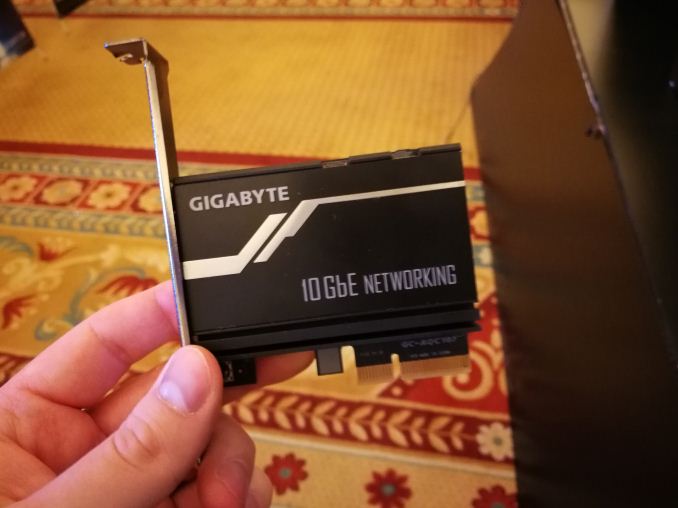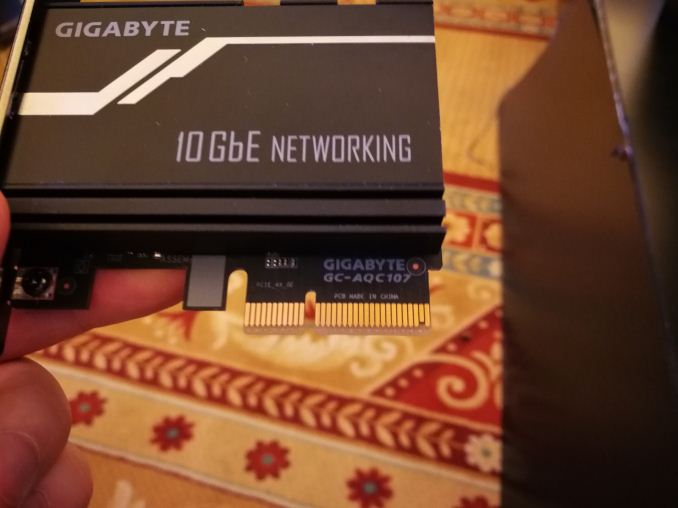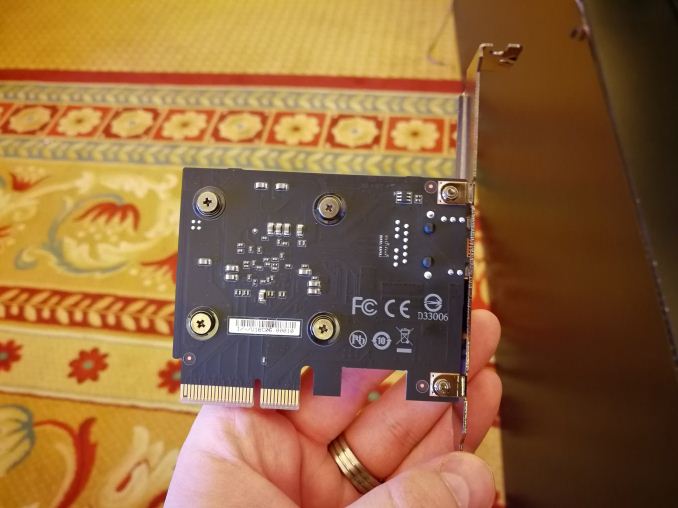GIGABYTE Exhibits an Aquantia AQC107 based 10G Ethernet PCIe Card
by Ian Cutress on January 11, 2017 3:00 PM EST- Posted in
- Networking
- Gigabyte
- 10GBase-T
- Aquantia
- 2.5GBase-T
- 5GBase-T
- PCIe
- RJ-45
- AQC107

During December, Aquantia announced that it will be launching two multi-gigabit NICs into the market, offering 2.5G/5G capability on both and one with 10GBase-T as well. We were told that industry partners would announce solutions with the chips in due course, and on Kaby Lake launch day we saw ASRock announce a pair of motherboards to come with the chips. GIGABYTE is also joining the fray, with a PCIe card to be potentially bundled with future motherboards or offered as a standalone product.
The GIGABYTE solution is a PCIe 3.0 card featuring a single 10G port, which allows for half-height and full-height PCIe slots. Only an AQC107 version was at the show for 10G, and it wasn’t clear if a 2.5G/5G version using the AQC108 would be inbound, but at this point in time GIGABYTE is keeping its cards close to its chest.
Aside from showing it exists, not much else was given – if it will be sold standalone, or what the extra price will be. The interesting thing for us to determine is the BOM cost (bill of materials) for the Aquantia chips – Aquantia has mentioned that they want to undercut 10G solutions significantly, and help drive multi-gigabit ethernet to both the PC and the backhaul of a home or business network. Having PCIe cards you can slot in certainly helps, and we mentioned to GIGABYTE that if this card hits the market in the $80-$100 range for a single port, that would help (and any cheaper would mean it will fly off the shelves).
A big question with multi-gigabit ethernet, especially 2.5G/5G, is the availability of consumer-grade switches and hubs. We might have to wait another 12-18 months for those to come through, and again, pricing is a concern here. Aquantia has said they are working with the major players in that space, but it will be up to them to announce products.
I’ve told GIGABYTE that when the cards are available, I will take a few for testing. I’m slowly building up a sizable stack of 10GBase-T controllers, and we might start looking into relevant networking tests for them for comparisons. Any suggestions, please let us know.
Related Reading:


















25 Comments
View All Comments
phoenix_rizzen - Wednesday, January 11, 2017 - link
It's a standard RJ45 port, why do you need to see pictures of it?vFunct - Thursday, January 12, 2017 - link
Need to confirm that it is standard RJ-45, instead of ARJ-45 or Tera or GG-45.eldakka - Thursday, January 12, 2017 - link
The 10GBASE-T standard specifies the 8P8C connector colloquially (tho after my wikipedia investigation, incorrectly) called RJ-45.If it uses an ARJ-45 or Tera or GG-45 connector then it does not meet the specifications of 10GBASE-T, therefore it won't be a 10GBASE-T card.
Sure, it could still be 10G ethernet, but it won't be BASE-T.
nowayandnohow - Wednesday, January 18, 2017 - link
I was actually thinking the same thing... what's the point of posting 8 images of the same side, and not one of the actual port (to see lights, placement, branding, etc)ignoramus_post-truth - Wednesday, January 11, 2017 - link
Suggested testing methodology:1. Test full-duplex (10Gbps uplink/downlink simultaneously for a total of 20Gbps).
2. Adopt Arstechnica's methodology. "First we test downloading a 1MB file four times: with 10, then 100, then 1,000, and then 10,000 concurrent clients. Then we do the same with a 100K file and finally with a 10K file. In general, the smaller the filesize, the more punishing the test is likely to be for the router. Smaller filesizes means more and smaller packets, plus more TCP sessions to make and break."
(see http://arstechnica.com/gadgets/2016/09/the-router-...
anomalydesign - Wednesday, January 11, 2017 - link
I am curious about the Akitio 10gbe "five speed" product line. They offer both a pcie 3.0 x4 card like this one as well as an external thunderbolt option. They've been on the market some time, and competitively priced, but I've had a hard time finding any detailed feedback about them. It would be great to see one included if you're doing a round upanomalydesign - Wednesday, January 11, 2017 - link
Product page link: https://www.akitio.com/expansion/10g-nbase-t-pcie-...OperativeOcelot - Thursday, January 12, 2017 - link
Don't get me wrong, this is cool and I definitely look forward to availability of new 10Gb RJ45 products coming to the consumer market, but what is the target audience? I see a lot of home lab enthusiasts utilizing used enterprise equipment with 10Gb or SPF+ switches and cards for dirt cheap prices.nowayandnohow - Wednesday, January 18, 2017 - link
i got a teamed 1+1GB link on my NAS, giving me 2 GB up/down, and 1 x 10GB on a few of my servers. I can transfer well up in the high 100's of MB/sec with this no problem from the NAS, and between servers about as fast as the HDD can spit it out.Target audience is people who need to move a lot of data, or have more than 100 users pushing the network. Do I NEED and can fully utilize the 10GB today? No, but I definitely run the couple of servers I have with lightning speed, and I'm waiting for you unimpressed consumers to adopt it instead of bitching about what you don't think you need. this discussion will be moot this time next year as more and more are coming with 10G connections per default, or use TB3 networking (40GBit).
drajitshnew - Thursday, January 12, 2017 - link
Could you please write an article regarding the cables and interface for 10 GbE. Fiber, vs cat 6E vs cat7; different types of fiber; SFP+ vs RJ-45; different types of SFP modules.